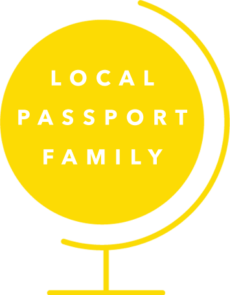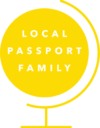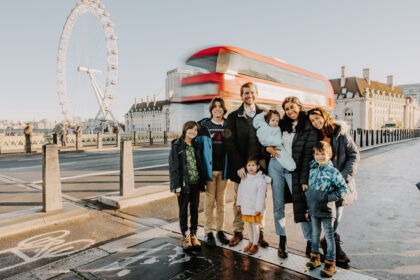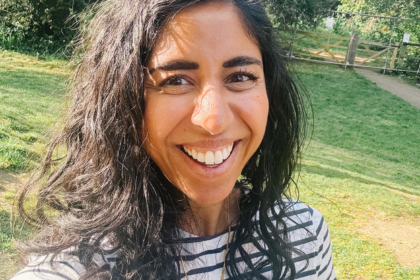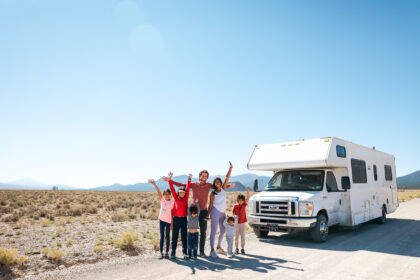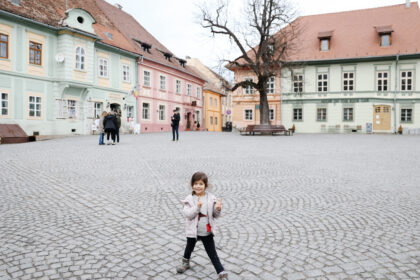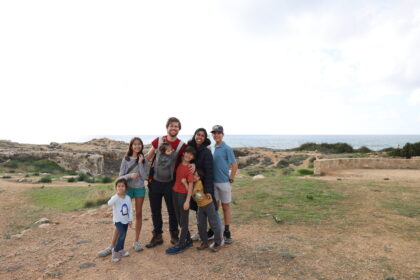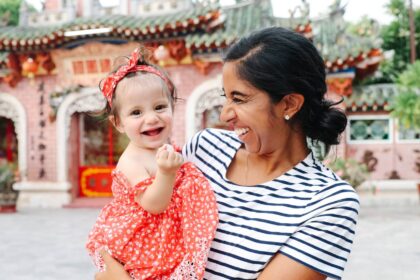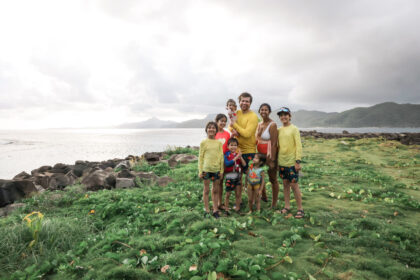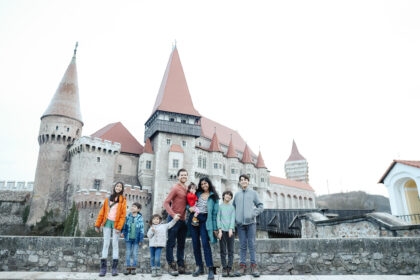Olympic National Park has the best mix of scenery all in one – rugged coastlines, alpine peaks, and temperate rainforests! It’s such a gem for families with young kids because of the diverse ecosystems and activities. We had an absolutely wonderful time as a family and loved finding the best things to do in Olympic National Park!
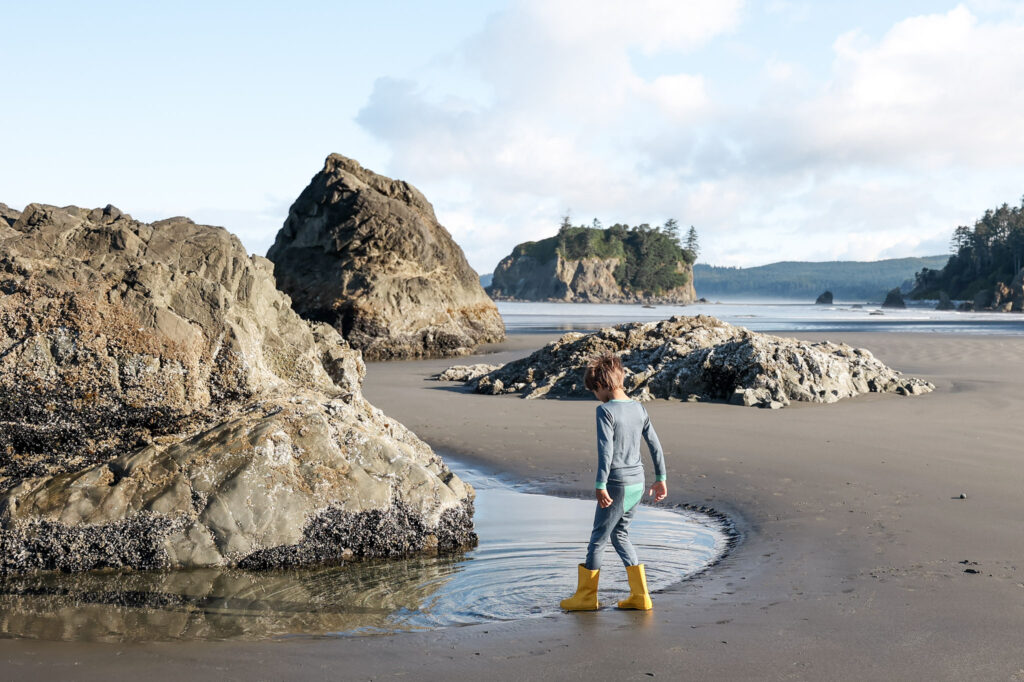
Learn About Olympic National Park
Before we visit a national park, our family loves learning about it! It helps us enjoy it more and appreciate the people who have stewarded it well before us. We love learning about the Indigenous history, as well as about wildlife and ecosystems.
Here are a few things to learn about Olympic National Park before visiting!
Olympic National Park History & Natural Features
- Humans have occupied the land presently known as Olympic National Park for over 13,000 years.
- There are 8 Olympic Peninsula tribes that continue to recognize a relationship to the park based on traditional land use, origin, beliefs, mythology and spiritual beliefs and practices: the Lower Elwha Klallam, Jamestown S’Klallam, Port Gamble S’Klallam, Skokomish, Quinault, Hoh, Quileute, and Makah.
- By the late 1700s, indirect contact with Europeans had a devastating effect on the lives of indigenous peoples of the Olympic peninsula. Thousands of tribal members died from epidemics of smallpox, tuberculosis, influenza and whooping cough, leaving large gaps in families.
- In the mid to late 1800s, a series of treaties established reservations for area tribes.
- Soon after, in the late 1800s, people came to prospect the peninsula as part of the British Columbia and Klondike gold rushes.
- The westward homestead wave reached the Olympic Peninsula in the mid-19th century. The earliest settlers clustered along the coast, near Hood Canal and present-day Port Townsend, Sequim, Port Angeles, and Neah Bay.
- In 1937 President Franklin Roosevelt visited the Olympic Peninsula and the following year he signed the act designating Olympic National Park.
- The park protects 922,651 acres, encompassing three distinctly different ecosystems: rugged glacier-capped mountains, wild Pacific coast, and magnificent old-growth temperate rain forest. Olympic is one of the most diverse wilderness areas in the United States.
- Olympic National Park’s 10 major rivers and the Pacific Ocean provide habitat for 37 species of native fish.
- The park protects one of the largest remaining blocks of old growth forest and temperate rain forest in the lower 48 states.
- While other mountain ranges are eroding, the Olympics continue to grow every year. Tectonic plates are colliding below the land we call Washington. As subduction of the Juan de Fuca plate below the North American plate occurs, the Olympic mountains are rising higher!
- (Source) (Source) (Source) (Source) (Source) (Source)
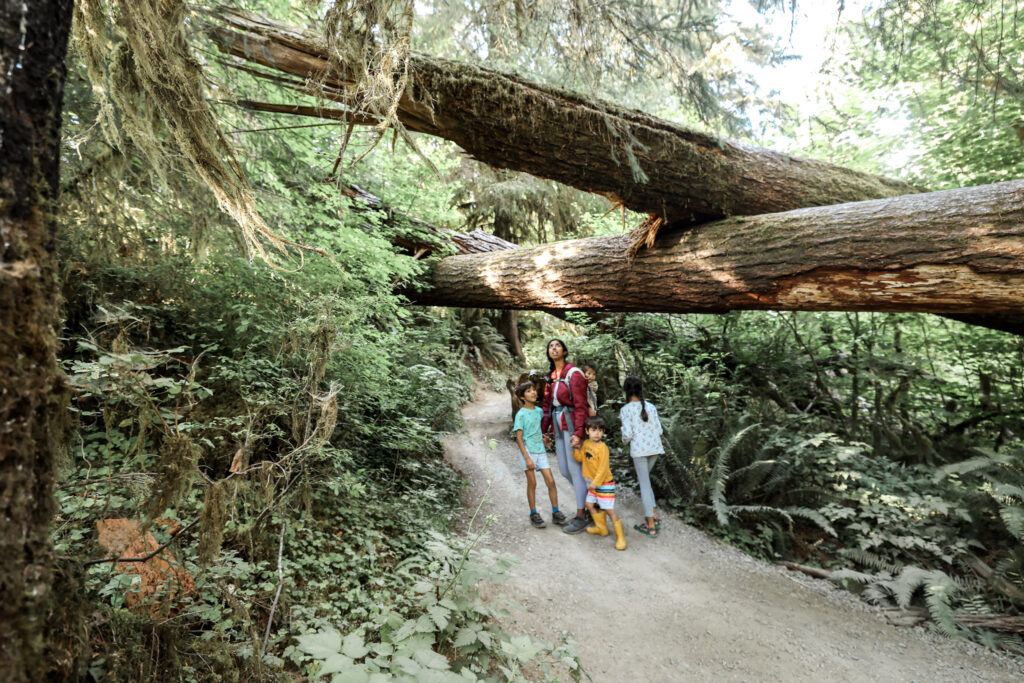
Olympic Indigenous History
- Indigenous peoples have used the land in and surrounding what is presently Olympic national park for hunting, fishing, ceremonies, and gathering plants.
- Eight contemporary tribes of the Olympic Peninsula – the Makah, Quileute, Hoh, Quinault, Skokomish, Port Gamble S’Klallam, Jamestown S’Klallam, and Lower Elwha Klallam – have lived in this area since time immemorial and continue to maintain strong relationships to the lands and waters now within Olympic National Park.
- The Makah Tribe has called the Neah Bay area home since time immemorial. The name Makah was attributed to the Tribe by the neighboring tribes, meaning “people generous with food” in the Salish language.
- The Makah had five permanent villages located along the shore of the northwestern-most point of the continental United States. In the early 1800s these villages were home to between two thousand and four thousand Makah.
- Each village contained several longhouses composed of cedar planks and measured approximately 30 feet wide and 70 feet long. The Makah and their extended families would share these structures and it was common to have several generations living in each one.
- The Makah were highly skilled mariners, using sophisticated navigational and maritime skills. They used various types of canoes carved from western red cedar, including whaling, halibut, salmon fishing, sealing, and large cargo. There were even smaller canoes which children used for practice.
- Various fish and marine mammals served as staple foods in the diets of peninsula indigenous peoples – which continues today.
- In 1855, the Makah negotiated and signed a treaty with the United States. In order to retain whaling rights, and to protect the health, education and welfare of their people, the Makah ceded title to 300,000 acres of tribal land to the U.S.
- Representatives of the U.S. Government sought to assimilate the Makah through the implementation of laws against potlatches, ceremonies and the Makah language. Their continued resistance against completely conforming to Euro-American standard is evident today in the Makah peoples’ continuance of their ancient culture.
- (Source) (Source) (Source)
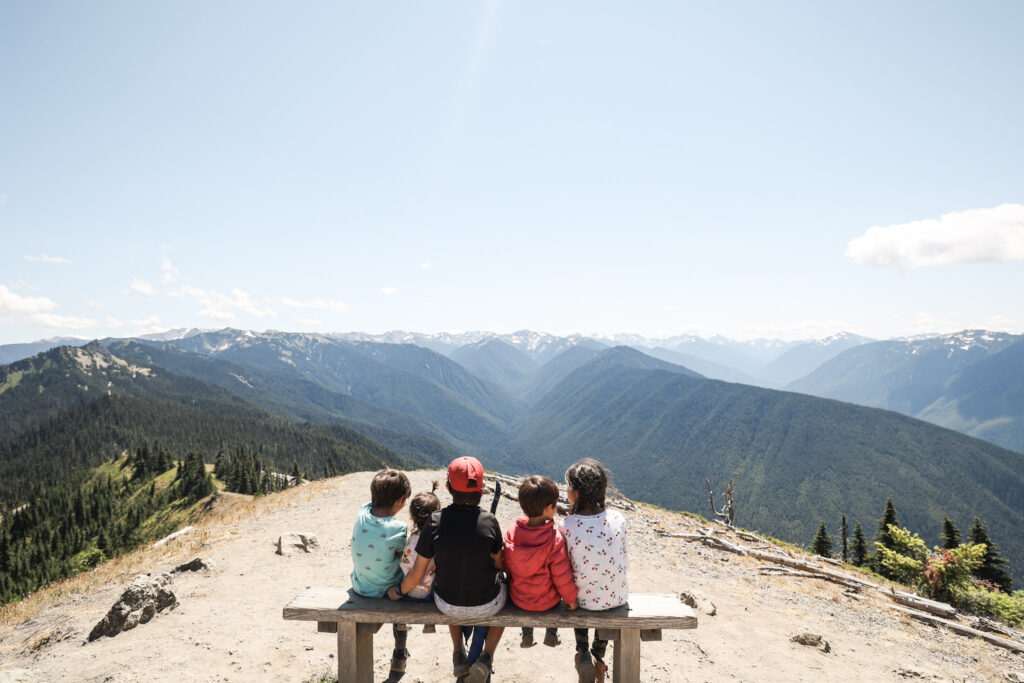
Featured Olympic Picture Book: Salmon Stream
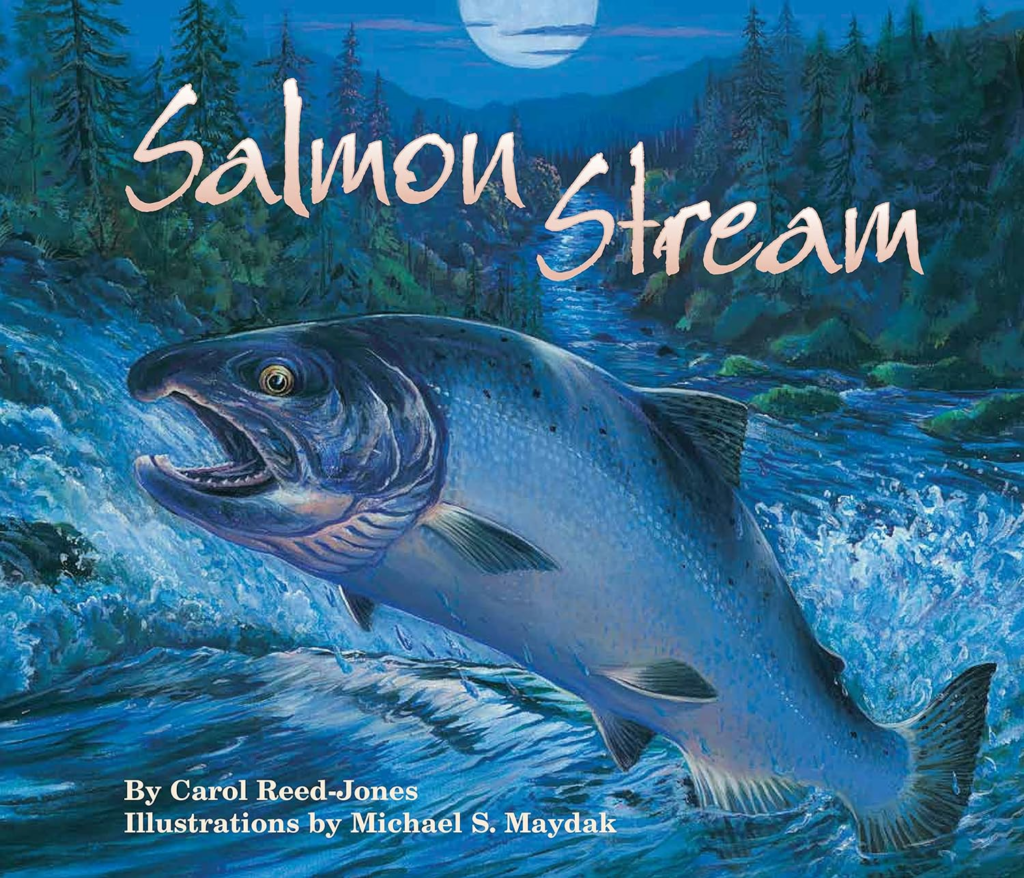
For a fun activity, you can make these salmon hats while learning about this keystone species.
Olympic Packing List: What to Pack For an Olympic Family Vacation
Olympic National Park Packing List
- Carry-all backpack – this is our favorite grown-up pack to carry essentials for a day hike
- Kids’ Hiking Backpack – our kids absolutely love these 18L hiking backpacks. They’re perfect as a day pack or for travel – they hold a ton, are sturdy, comfortable, and have a spot for a water bladder. They even work really well on my short torso and I alternate between one of those or this women’s day pack. We also love this 12L kids day hike backpack for younger kids.
- Backpacking Backpack – if you’ll be doing any overnight adventures, we really love this 40L pack for overnights.
- Layers
- Wool base layers + Socks – great for regulating temperature and moisture wicking. Excellent for cold weather, too. Here are all our favorite wool base layers & socks for the whole family.
- Sun protective gear – long shirts or hooded sun shirts work well.
- Rain gear – you will for sure want to pack rain gear when visiting Olympic National Park – even the “dry” months of July and August can get sudden storms!
- I love the bright colors of these REI Co-op rain jackets, as well as how packable they are: Women’s rain jacket, Men’s rain jacket, Kids’ rain jacket, Toddler rain jacket, Baby one piece rain suit
- These REI Co-op rain pants are also really excellent. Waterproof and take up almost no room/weight when packing. Great to wear for wind protection or to stay dry in the snow with layers under, too – especially if you’re traveling but won’t be actively outside for super long periods: Women’s rain pants, Men’s rain pants, Kids rain pants, Toddler rain pants
- Sturdy shoes
- These are our favorite hiking boots for women and men, and these hiking sandals for women and men.
- I’d recommend either sneakers with good tread or hiking shoes when exploring Glacier trails with kids. My kids love either hiking sandals, hiking boots, or regular sneakers depending on the type of hike. (I personally prefer my kids to wear kids hiking boots because they’re comfy & waterproof for longer hikes, or the best hiking sandals if we’ll be in water. All our favorites are also available HERE.)
- First aid kit and my favorite bandages (here are all the first aid items we pack when traveling)
- Sunscreen
- I love this kind for kids – it’s mineral-based, provides great protection, great for sensitive skin, and rubs in easily. This is my favorite facial sunscreen for myself (use code LPF15 for 15% off).
- Insect Repellent
- It can definitely get buggy around here, especially in the summer. We love this deet-free repellent (use code LPF15) and this Picardin-based bug repellent in areas that don’t have a high prevalence of disease-carrying mosquitos (we use Deet in Zika/dengue/malarial areas).
- Quick-Dry Towel
- We like to have one of these quick-dry towels on hand in case of rain or any spills. I also really love these ribbed quick dry towels!
- Hat
- This is my favorite hiking hat and my favorite hat for babies.
- Camera equipment
- Water/snacks
- We love this water bottle and this water bottle for adults.
- This hydration backpack for kids is a favorite. (Also available here.)
- My older kids LOVE this water bottle.
- This and this are our favorite water bottles for toddlers.
- Child hiking carrier – Olympic National Park has a number of wonderful hikes, and we love having a carrier to pack along a baby or toddler when visiting Olympic with kids. This is our favorite backpack hiking carrier for visiting Glacier National Park with toddler that also has plenty of room for snacks and even our big camera. We also love this soft structured carrier for younger babies, and this one is excellent for travel, especially if you won’t be using it all the time (it packs up small) or will be getting wet (it dries in a flash).
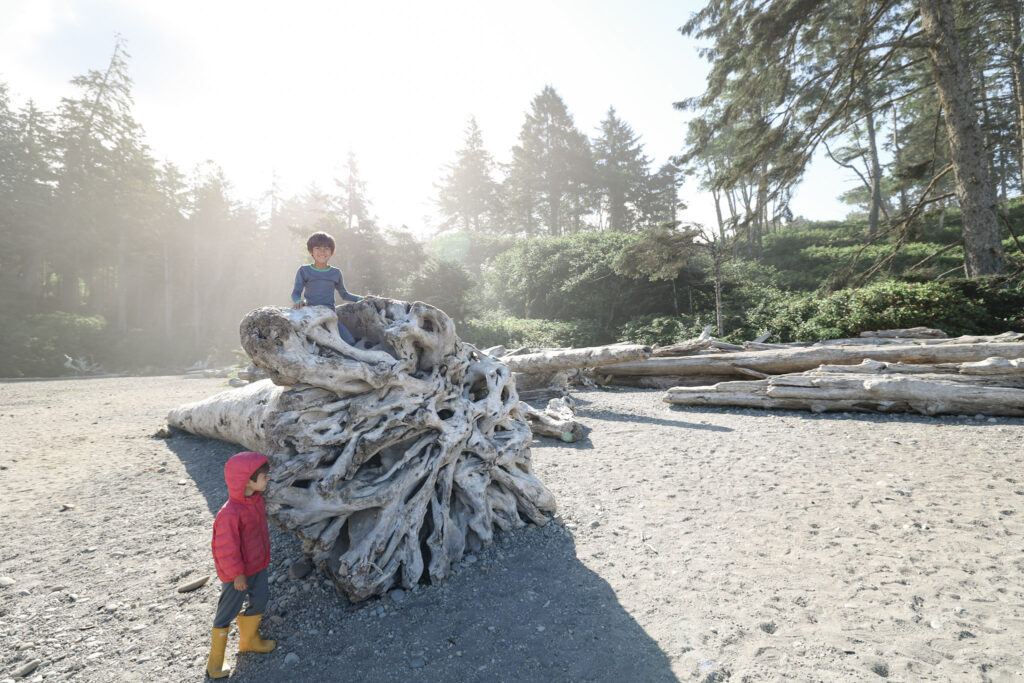
How To Get to Olympic National Park
The closest U.S. airport to Olympic National Park is Sea-Tac International, near Seattle, WA. From Seattle, you’ll want a car to get around Olympic National Park. The park is large and spread out, and some of the areas are quite remote. You can drive around the Puget Sound to reach the peninsula or take a ferry over with your vehicle.
You can also fly to Vancouver International Airport. From there you can take the Coho Ferry (with your vehicle) from Victoria or drive across the border and follow the options above.
How Many Days Should I Spend at Olympic National Park?
Where to Stay Near Olympic National Park: Olympic Lodging for Families
Camping in Olympic National Park
Olympic Lodging with Kids
Accommodations Inside the Park
- Kalaloch Lodge is the only year-round option and offers cabins and lodge rooms.
- Lake Crescent Lodge is typically open spring through the rest of the calendar year. You can book cottages, cabins and lodge rooms.
- The Log Cabin Resort is only open during the high season (May-September) and offers chalets, cabins and lodge rooms.
- Sol Duc Hot Springs Resort has cabins and suites from March to November.
- Olympic View Inn
- Sol Duc Cabin
- Pacific Inn Motel
- Captain’s Cottage
- Red Lion Inn & Suites
- NW Olympic Retreat
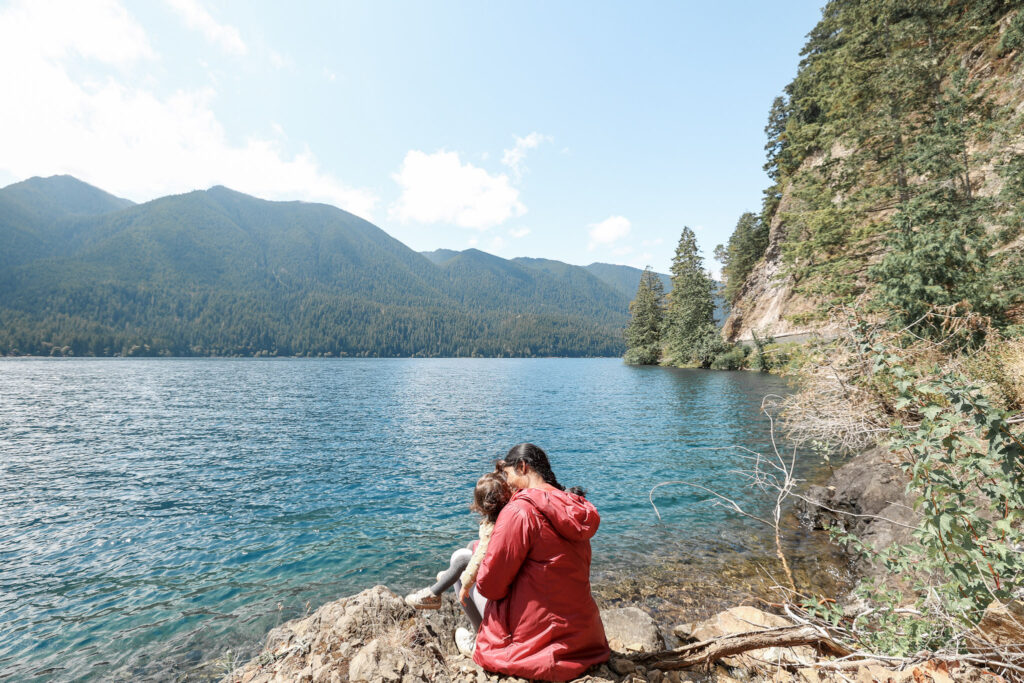
Where to Eat near Olympic National Park
Where to Eat in Olympic National Park
Each of the lodging options within the park offers a restaurant and/or deli.
Where to Eat near Olympic National Park
- Blackberry Cafe: Diner-style breakfast, lunch and dinner in Port Angeles.
- Oak Table Cafe: Breakfast and lunch in Sequim and Silverdale.
- First Street Haven: Breakfast and lunch in Port Angeles.
- Hama Hama Oyster Saloon: Seafood lunch on weekends in Lilliwaup.
- Little Devil’s Lunchbox: Burritos, tacos and sandwiches for lunch in Port Angeles.
- Finnriver Farm and Cidery: Lunch and dinner in Chimacum (between Sequim and Port Townsend).
- Sea J’s Cafe: Casual lunch and dinner in Port Townsend.
- Granny’s Cafe: Diner-style lunch and dinner in Port Angeles.
- Barhop Brewery and Pizza: Popular pizza spot for lunch and dinner in Port Angeles.
- Alder Wood Bistro: Dinner in Sequim.
- Bella Italia: Italian dinner in Port Angeles.
How to Get Around Olympic National Park: Olympic Transportation
You will most definitely need a vehicle to visit Olympic National Park, as transportation options on the peninsula are quite limited and there is no shuttle in the park. Olympic National Park is large and the can’t miss spots are spread throughout.
Best Time to Go to Olympic: Olympic National Park Weather
Shoulder seasons of spring and fall are also a good time to visit Olympic National Park. Some seasonal accommodations (both campgrounds and lodging) are open as early as April and as late as November or even December. The weather will be cooler and wetter, but the park is just as beautiful. Note that shoulder seasons are extended here, and it’s not unusual to see snowfall at higher elevations as late as June and early as September.
It’s possible to visit Olympic National Park during winter, but you’ll want to be prepared with rain gear and plenty of packed food. Services are much more limited during the winter months and camping isn’t recommended. Olympic experiences high levels of precipitation during winter – up to 170 inches in some areas. That said, you will have the park largely to yourself and may even experience the magic of a frosty rainforest. Large amounts of snow blankets high elevations in the park. Hurricane Ridge averages 30-35 feet of snow and is open to weekend skiing when weather permits. Flooding and severe storms can close roads and limit access to park areas. If visiting during winter, check the campground, road, and trail status pages for any weather-related closures, as well as avalanche conditions before any ski or snowshoe trip.
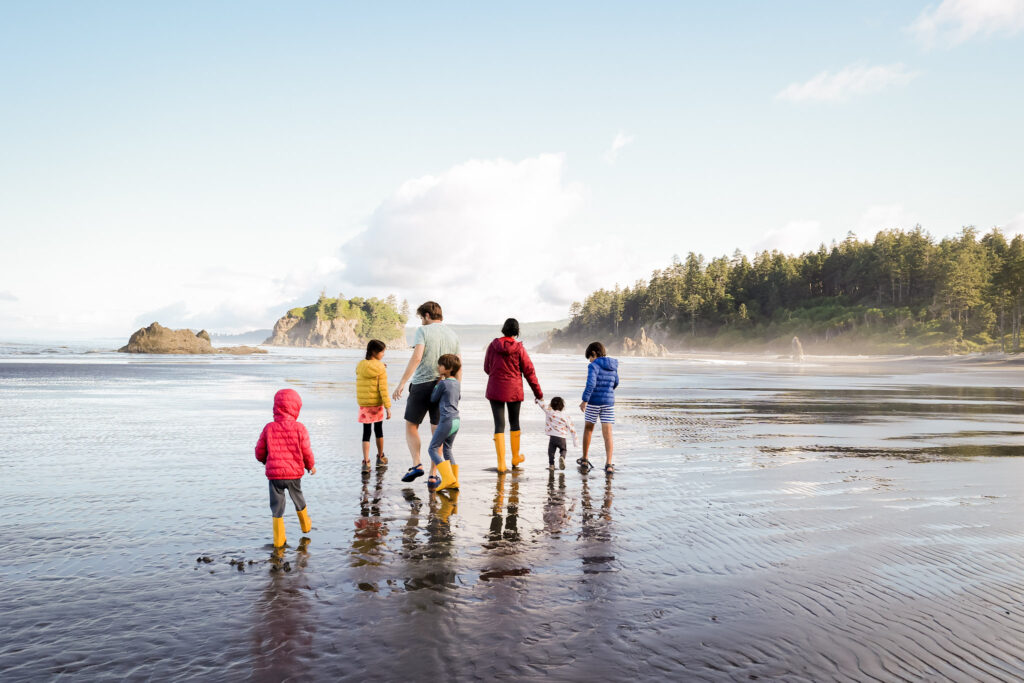
Top Olympic Checklist of the Best Things to Do in Olympic National Park
- Visit a temperate rainforest: the Hoh Rain Forest is the most popular – and for good reason! – but for those who have visited both, the Quinault Rain Forest is often the top pick. See below for recommended hikes in both.
- Go Tide Pooling (more info below)
- Hike to Sol Duc Falls
Best Things to Do in Olympic National Park: Olympic National Park Itinerary & Unique Things To Do in Olympic National Park
1. Check Out the Visitor Centers
Staff at the park’s two visitor centers (Olympic National Park and Hoh Rain Forest) can help with trip planning and answering any questions you may have. Be sure to pick up free maps check other park publications via the visitor center bookstores. The main visitor center is the Olympic National Park center in Port Angeles and is open year round. The Hoh visitor center has most of the same amenities but is closed January-March and also has limited hours outside the summer. Check this page for more details about visitor center hours.
2. Explore A Temperate Rain Forest
This is an absolute must-do activity when visiting Olympic National Park. While Hoh Rainforest is the most famous and is stunning, there are actually a total of 4 temperate rainforests in Olympic National Park – Quinault, Queets, Hoh, and Bogachiel. They’re some of only a few temperate rain forests in the world in the world, with others in Chile, New Zealand, and Australia. Keep an eye out for big trees, nutrient-rich nurse logs, plants growing on the bigger trees, and abundant wildlife.
3. Go Tidepooling in Olympic National Park
Much of Olympic National Park lies on the coastline, and there are several excellent spots for tidepooling. If you’re not familiar with tide pooling, this is when you can go out into the tide pools, or the areas of shallow water that “pool” during low tide, to see all kinds of marine creatures – anemones, crabs, urchins, and more. It’s so fun for kids and adults!
The most popular tidepools in Olympic National Park are at Kalaloch’s Beach 4 and Mora’s Hole-in-the-Wall, a beautiful natural bridge area. Keep in mind that Hole-in-the-Wall will require a 2-mile (each way) hike to get to, and is only accessible during low tide (be sure to check so you don’t get stranded!).
Second Beach, Third Beach, and Ruby Beach are also excellent places to view intertidal life in the park. Ruby Beach (one of the northern Kalaloch Beaches) was our personal favorite – it was fairly easily accessible but not right by the parking lot (about a 10 minute walk down, with some driftwood to climb over), which kept it pretty quiet. There are also vault toilets in the parking area. The beach has excellent tide pooling, gorgeous sea stacks, and just an overall stunning inlet area with a wide beach at low tide for kids to run and play. We loved it!
I personally like to have my kids wear either our favorite hiking sandals (that can get wet) or rain boots when tide pooling. They protect feet from sharp rocks and are easy to manage with both water and sand as these shoes rinse off easily. You’ll want shoes with good tread as it can get quite slippery.
When tide pooling, make sure to keep an eye out for dangerous sneaker waves (and keep an eye on the tide schedule) and keep little ones close. Go to this page for more safety tips when tidepooling in Olympic National Park. Also, be sure to leave any sea creatures alone. Take care not to step on them, poke them, or move them. They’re in their home and you’re a visitor, so be respectful of their space. 🙂
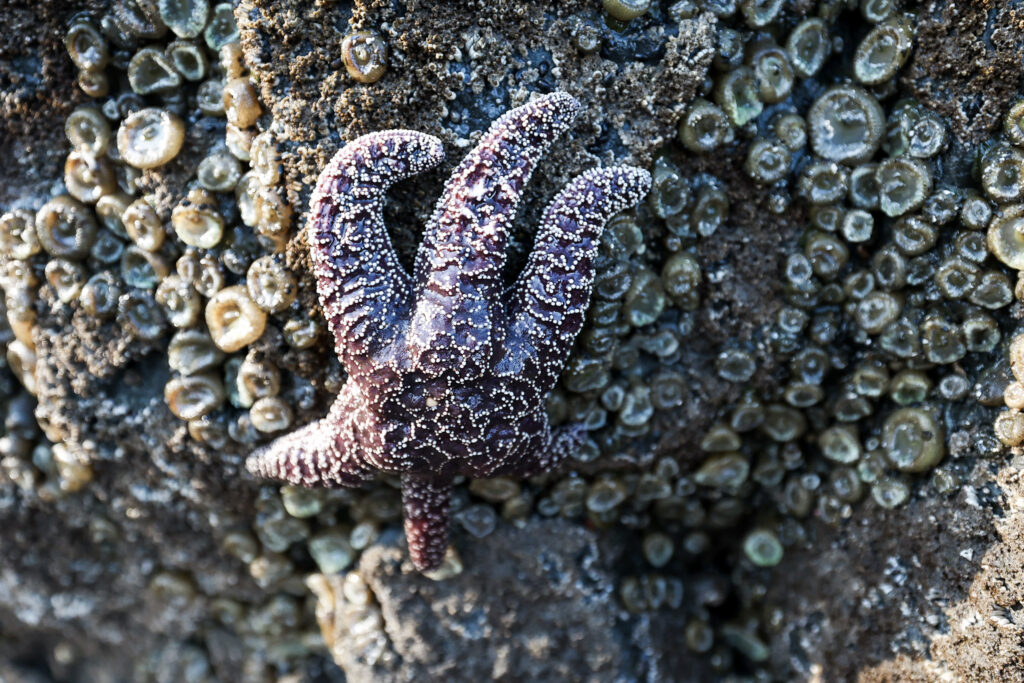
4. Junior Ranger Program
There are also special programs geared to younger visitors. Pick up a wonderful Junior Ranger booklet at a park visitor center to learn more about the park, its history, ecology, and conservation. Olympic National Park also has an Ocean Stewards Program, a fun, hands-on program for children ages four and up. If your young ones are interested in the coastal ecosystem, grab a booklet to complete for a special patch.
While you’re at the Olympic National Park visitor center, be sure to check out the Discovery Room, which is full of interactive exhibits for kids. You can go to this page in advance to get unique activities to try while in the Discovery Room.
5. Hiking at Olympic National Park: Best Hikes for Families at Olympic National Park
Here are a few family-friendly hikes in Olympic National Park:
- Sol Duc Falls – 1.8 miles, 200 ft. elevation gain
- Hall of Mosses – 1.1 miles, 78 ft. elevation gain
- Spruce Nature Trail – 1.4 miles, 16 ft. elevation gain
- Kestner Homestead Trail – 1.3 miles, 42 ft. elevation gain
- Hurricane Hill – 3.4 miles, 826 ft. elevation gain
- Marymere Falls – 1.7 miles, 298 ft. elevation gain
- Heart O’ the Heart Forest – 4.4 miles, 800 ft. elevation gain
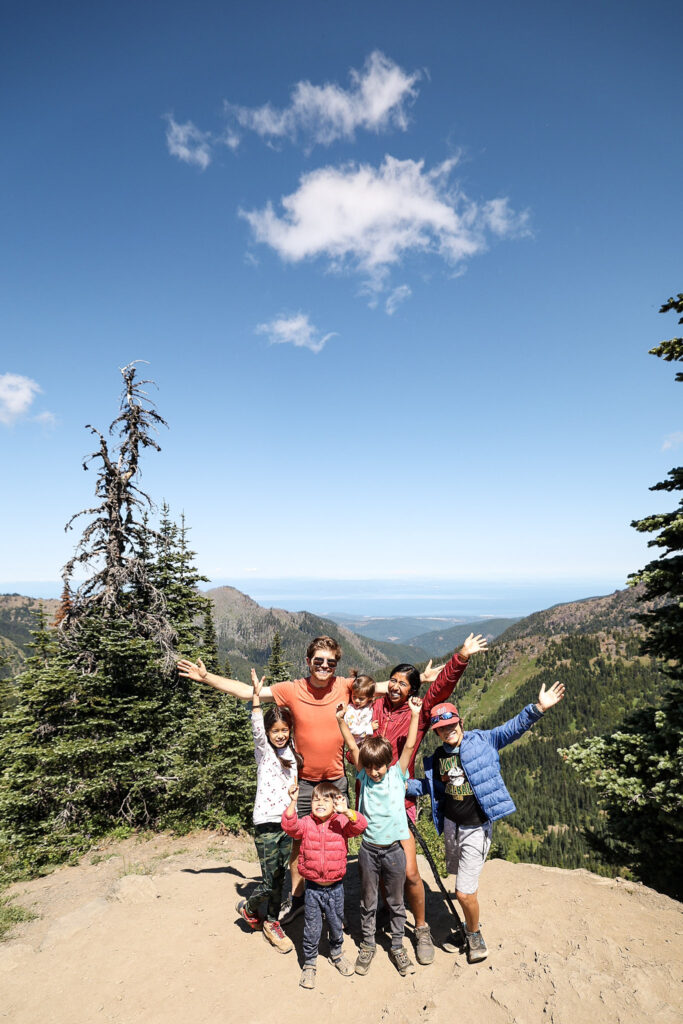
6. Play on the Beach
There are tons of beaches in and around Olympic National Park. These won’t be sunbathing, extensive swimming beaches – even in the summer, they tend to be cold and often windy (though you might get lucky with a warm and sunny day!). Instead, we love these for their dramatic scenery and exploring. The La Push beaches are especially great for their views and variety.
First Beach (La Push Beach) is not within the park boundaries and is instead Quiluete land. The entire area is the native land of the Quiluete tribe, and this area in particular belongs to their families and residences, so please take extra care. We love this one for walking and exploring driftwood. It’s a convenient one because it doesn’t require any hiking to access, and has a gravel parking lot next to it. This beach does not have good tide pooling opportunities but is great for running and playing in the sand.
Second Beach requires a 5-6 mile round trip hike to access. While it’s beautiful and tends to be less crowded, it certainly requires more effort.
Third Beach also requires a hike (about 4 miles RT) and has views of The Giants Graveyard, some beautiful sea stacks, in the distance. This one tends to be the least crowded.
7. Kayaking or Boating in Olympic National Park
If you have a kayak or canoe, Olympic National Park has plenty of options for a water adventure. From the Elwha River to Lake Crescent, there are plenty of scenic paddling options, as well as those for more experienced kayakers. Before your trip, always check river flows and conditions. Visit the USGS website for specific river conditions. Always stop by a ranger station to inquire about closures.
We personally loved taking our inflatable boat out on Quinault Lake – it was such a lovely place to paddle and very calm. A couple of our braver family members jumped in to swim in the cold lake!
See this page for more about boating opportunities and staying safe on the water in Olympic National Park.
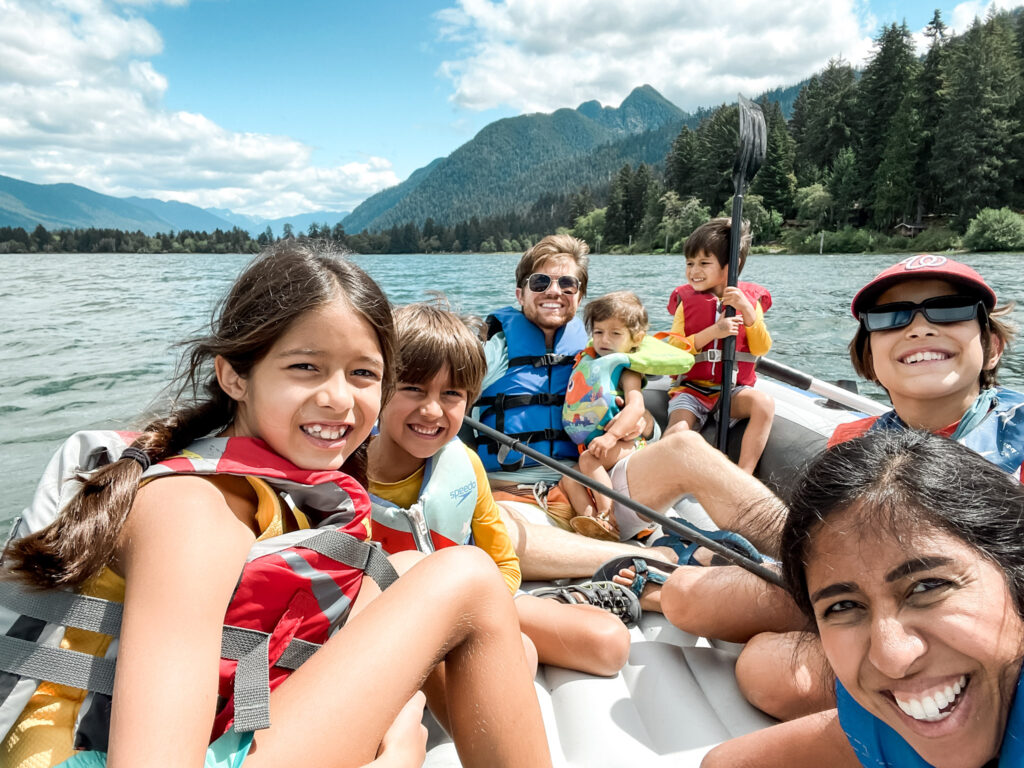
8. Try a National Park Audio Tour
Olympic National Park has a cell phone tour! As you’re driving through the park, this is a great way to connect with your surroundings and learn a bit more about the park’s history and ecosystems. To use the audio guide, dial 360-406-5056 from your cell phone. You’ll then be able to select guides for these areas of the park: Hurricane Ridge, Elwha, Lake Crescent, Sol Duc, Mora/Ozette, Hoh, Kalaloch, Quinault, and more!
9. Join a Ranger Program
Ranger-led programs are available throughout the summer at popular destinations and campgrounds throughout Olympic National Park. This is a great way for visitors of all ages to learn more through ranger-guided interpretive walks, campfire programs and more.
Snowshoe with a Ranger: During the winter, ranger-guided snowshoe walks are offered at Hurricane Ridge. As soon as there is enough snow, rangers will offer snowshoe walks at 1:30 pm on Saturdays and Sundays. These walks last 1.5 hours, cover less than a mile, and include 130 feet of elevation gain. Snowshoes and instructions are provided.
Check the Calendar for these and other park events, or refer to Olympic’s official newspaper, The Bugler.
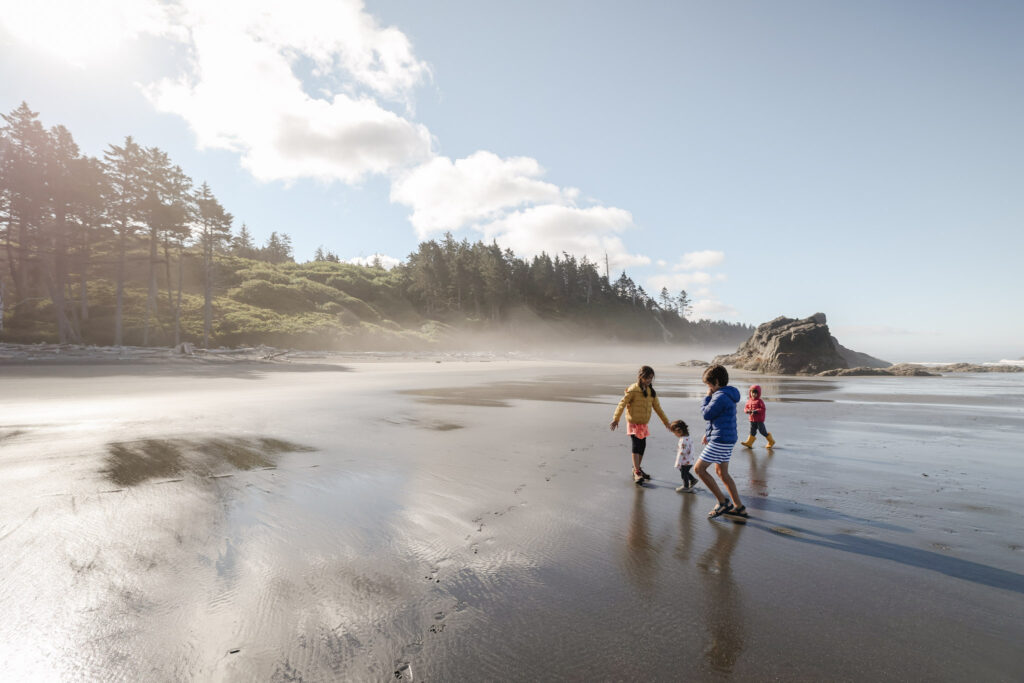
10. Stargazing at Olympic National Park
With 95% of the park designated as wilderness and an absence of human-caused light, Olympic is a perfect place to experience natural darkness and the splendor of our natural lightscape. Spend an evening on a mountain peak, along the coast, or at your campsite leisurely viewing the night sky or join in one of our night sky programs offered during the summer.
Hurricane Ridge Astronomy Program: Join a Master Observer at Hurricane Ridge for an evening of astronomy and star-gazing. On a clear night, visitors will be able to gaze on thousands of stars, as well as galaxies, constellations, nebulae, and planets. Additional program information.
11. Sledding and Tubing at Hurricane Ridge
Hurricane Ridge is a great place to bring your sled or snow tube during the winter! There is a Children’s Snowplay Area west of the Hurricane Ridge parking lot, where children eight and under can sled for free. You must bring your own tube or sled; sleds with runners are not allowed.
For children ages nine and older, sledding is only permitted at the tubing park within the Hurricane Ridge Ski Area. You must use the tubes provided by the ski area. Visit the Hurricane Ridge Ski and Snowboard Area website for additional information on the tubing hill.
12. Visit Hot Springs
Olympic National Park is one of the few that allows visitors to soak in mineral pools! Head to Sol Duc Hot Springs Resort for overnight or day use facilities with 3 mineral pools and 1 fresh water pool. There is a separate fee to enter these pools.
If you prefer natural hot springs, Olympic Hot Springs are an option, although it is much more difficult to get to this wilderness area (accessible only by foot) and the water here is not tested or treated. More information HERE.
13. Go Cross Country Skiing or Snowshoeing in Olympic National Park
With its easy access and 15 to 20 miles of routes, Hurricane Ridge is the focus of cross-country skiing and snowshoeing in Olympic National Park. Winter explorers of all abilities can enjoy the area, flat, easy, beginner ski terrain in the meadows above the parking area. Backcountry skiers can explore several slopes and bowls in the area. No trails are groomed or marked, however two routes use unplowed roads, which can usually be easily navigated.
Before heading out, be prepared for steep terrain and the possibility of avalanches. Check current avalanche conditions before your trip. For a winter map of the area with descriptions of snowshoe and ski routes, check here: Hurricane Ridge winter map.
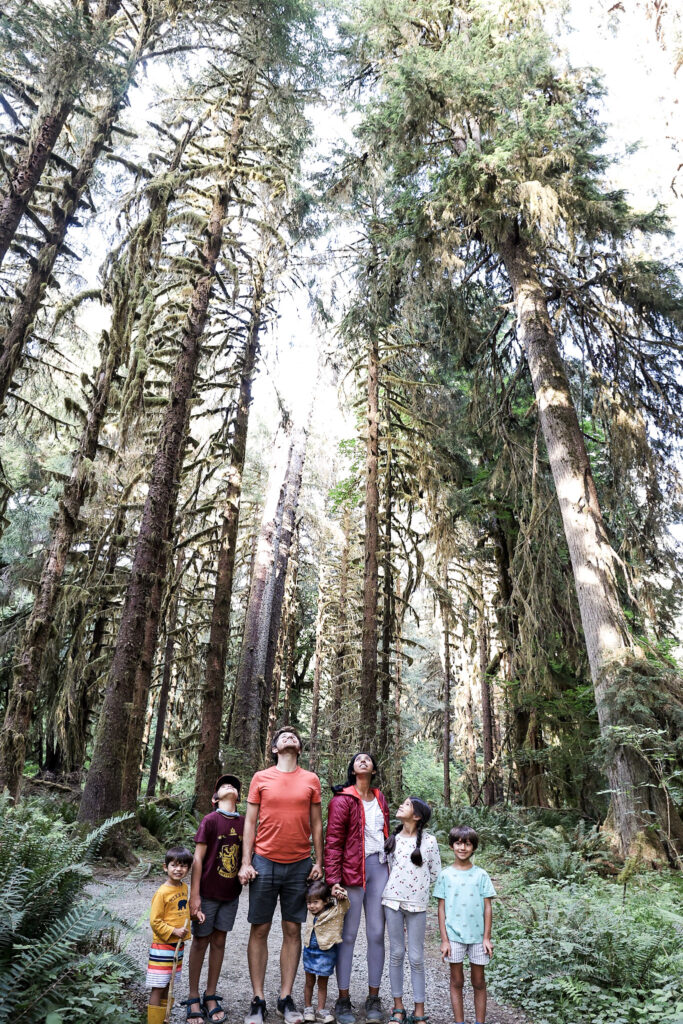
14. See the Wildlife at Olympic National Park
There are many wild animals that call Olympic National Park home. And although there are plenty, the wildlife can sometimes be hard to spot. Here are some tips for wildlife viewing at Olympic National Park:
- Watch at dawn and dusk: Most wildlife activity occurs around dawn and dusk, when animals feed. Plan excursions during these parts of the day to increase your chances of seeing wildlife.
- Bring the right tools: Field guides, binoculars, a zoom lens, and comfy shoes can improve you wildlife viewing experience.
- Know their habits and habitats: Habitat preferences and seasonal cycles can determine where and when you’re most likely to observe an animal. You probably won’t see a marmot on the coast or a river otter at Hurricane Ridge. Migratory animals, such as gray whales, are most commonly seen in the spring and fall and animals that hibernate, such as marmots, are usually only seen in the summer. Learning about wildlife habits and habitats before you visit will increase your chances of an encounter.
- Ask a ranger: Stop by the nearest Visitor Center for current information on the best wildlife viewing areas.
For safety tips and more about where to find specific species, check out the park’s Wildlife Viewing page.
15. Fishing in Olympic National Park
Olympic National Park protects over 75 miles of Pacific Coast, 800 lakes, and 4,000 miles of rivers and streams that support some of the most extensive runs of wild salmon, trout, and char remaining in the Pacific Northwest. Before you go fishing in Olympic National Park review the current fishing and shellfish regulations and check bulletin boards for locally posted regulation changes. And see this page with guidance for catch and release fishing.
16. Salmon Viewing in Olympic National Park
Olympic’s rivers are home to all five species of Pacific salmon. Although there are salmon migrations throughout the year, fall is the best time to view the salmon’s dramatic upstream journey. Most rivers in the park host a fall salmon run, but the Salmon Cascades Overlook in the Sol Duc Valley provides one of the best views from late September to Early October.
17. Photography in Olympic National Park
- Head up Hurricane Ridge for both fantastic landscape photography opportunities, as well as wildlife viewing. Keep an eye out for the Olympic marmots.
- Visit the coast in spring and fall to photograph migrating whales.
- While hiking the rainforests, try some macro photography on the many layers of flora or take some shots of the Roosevelt elk.
Photo Equipment
- Camera
- 70-200mm lens (for wildlife)
- 24-70mm lens
- 15-35mm lens (for astrophotography)
- Tripod
- ND Filter
- Remote
Enjoy Your Visit to Olympic National Park with Kids!
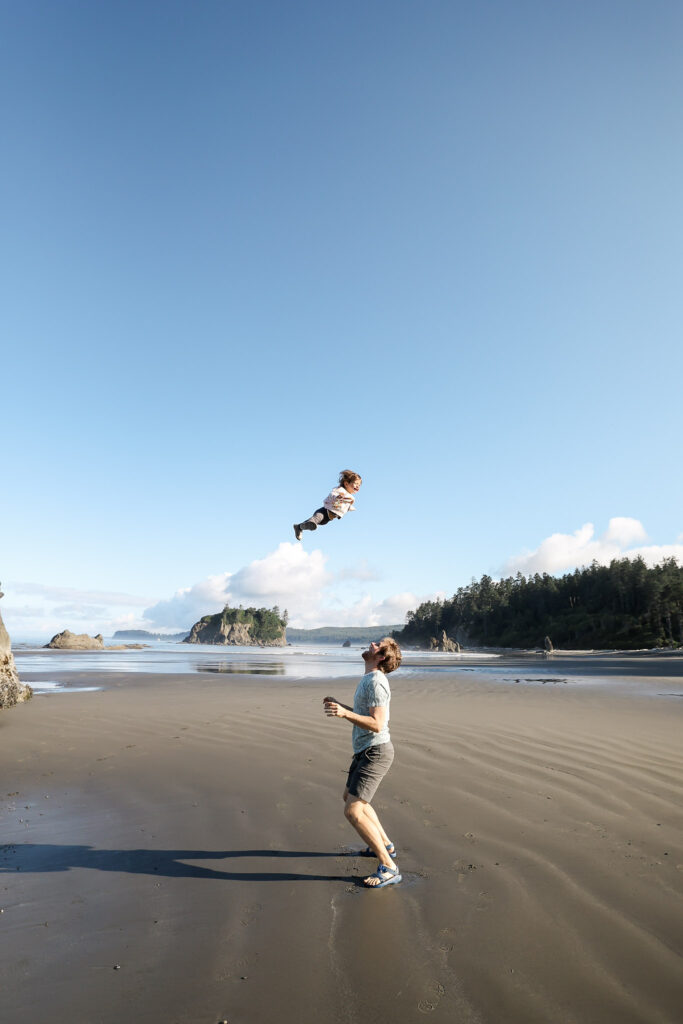
MORE POSTS
IF YOU LIKED THIS POST ABOUT THE BEST THINGS TO DO IN OLYMPIC NATIONAL PARK, YOU MIGHT LIKE THESE POSTS TOO:
- What to Pack for Alaska With Kids: Alaska Summer Packing List
- Best US National Parks by Month
- 10 Tips for Family Travel on a Budget
